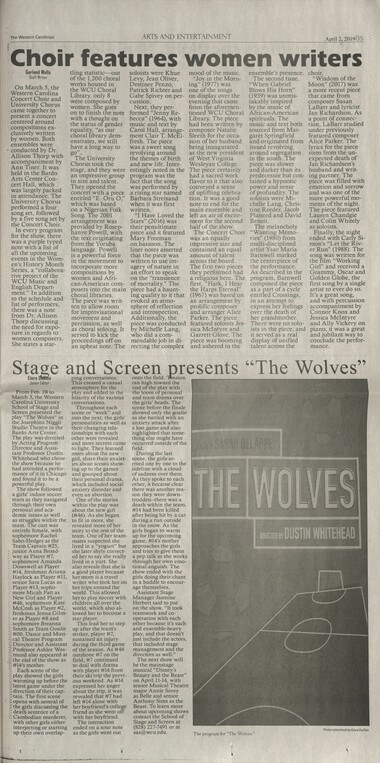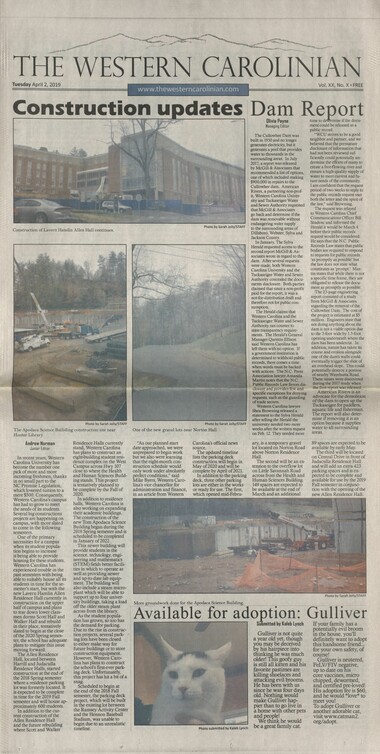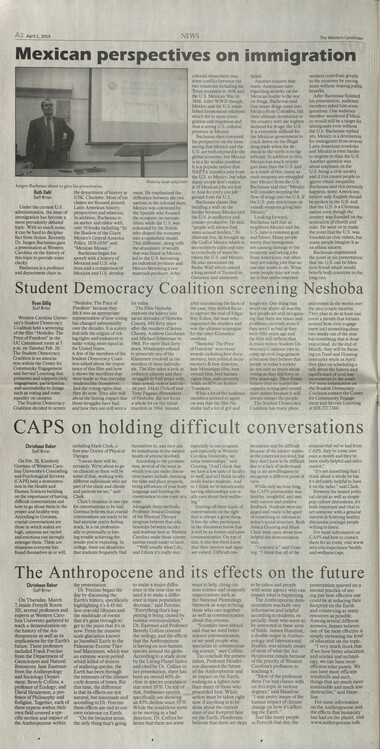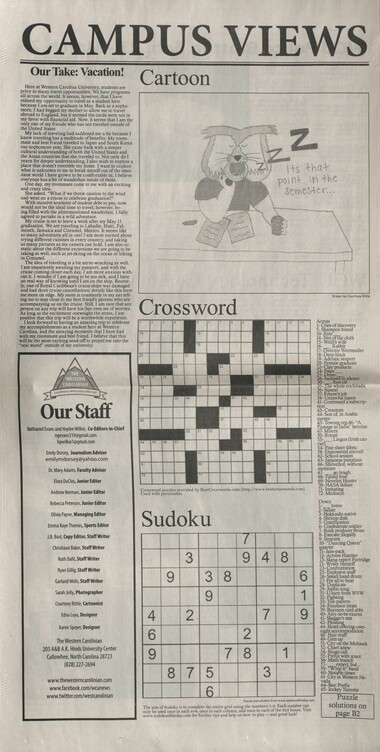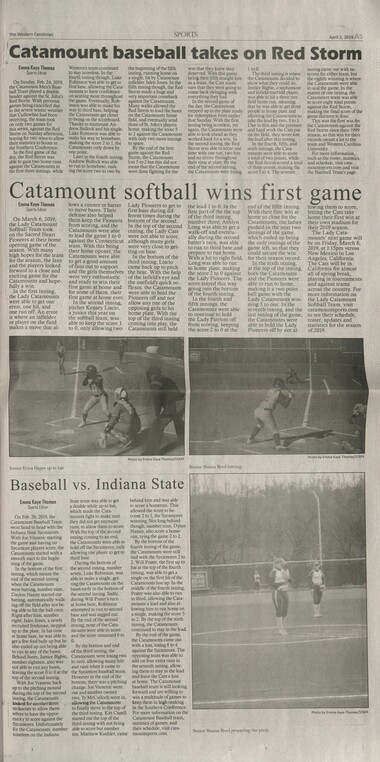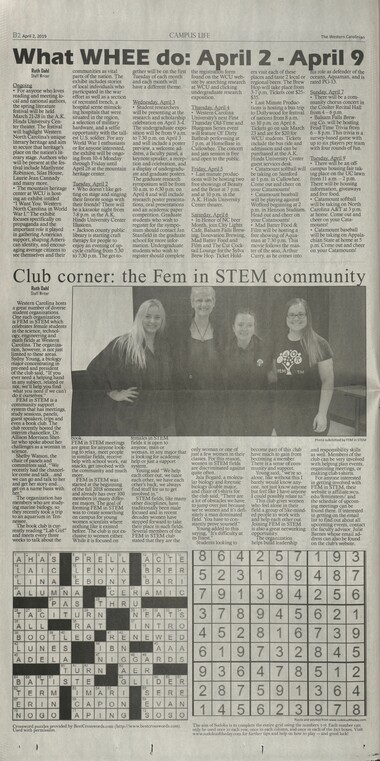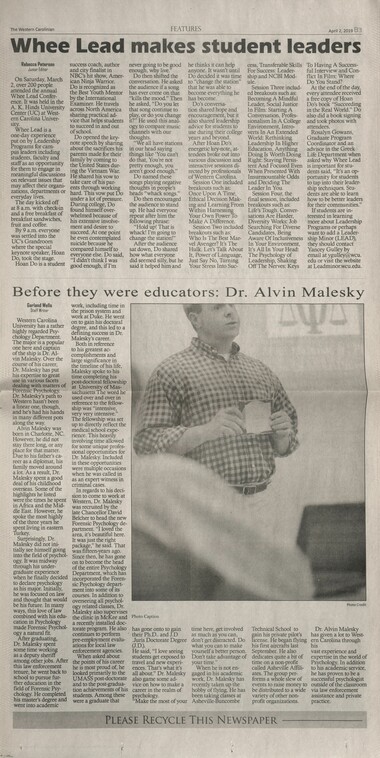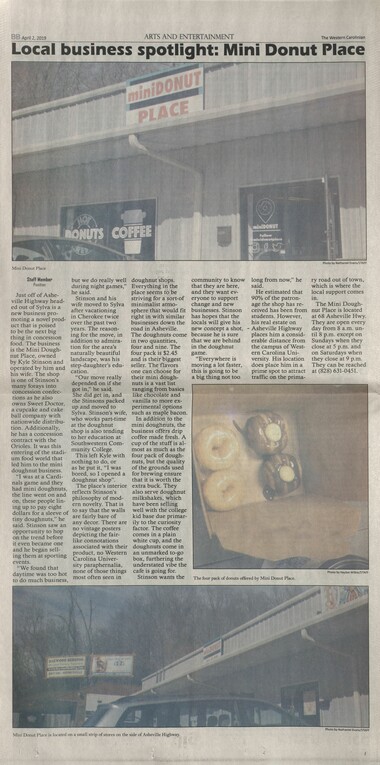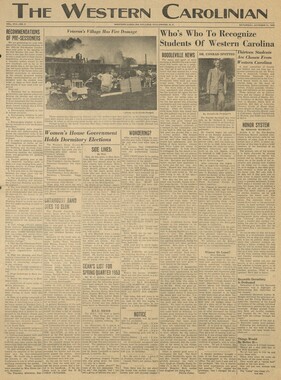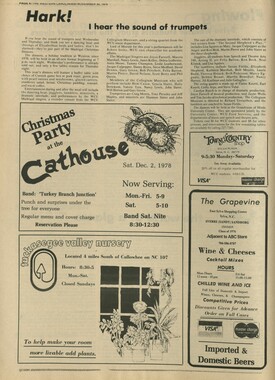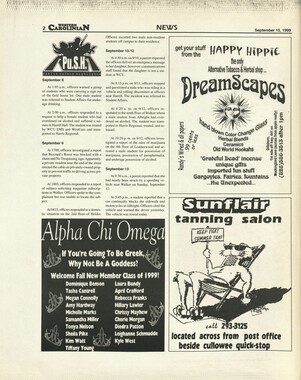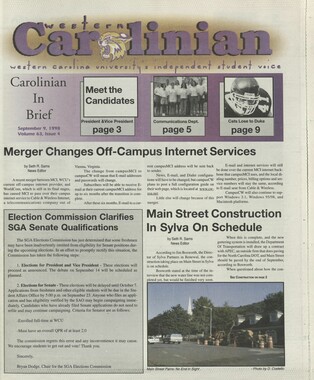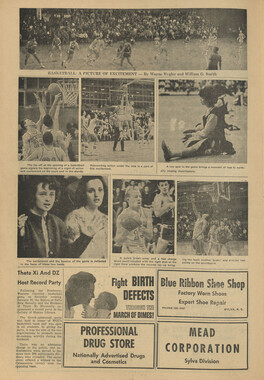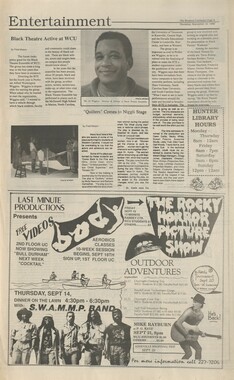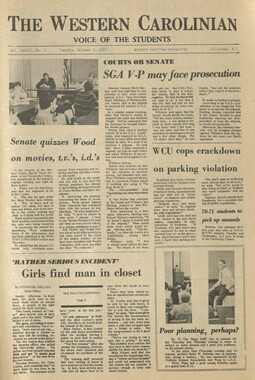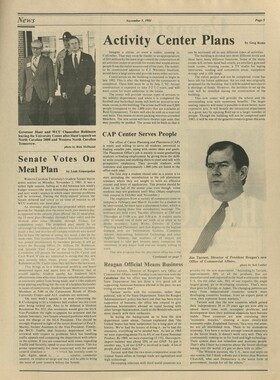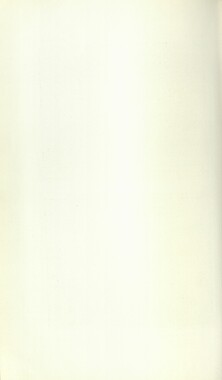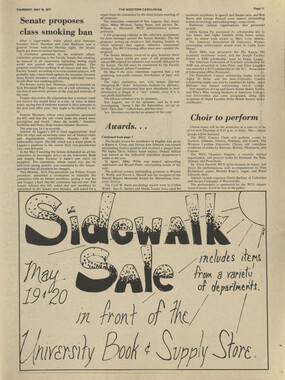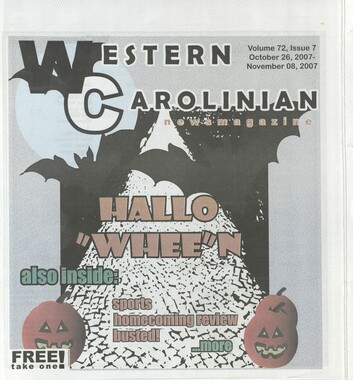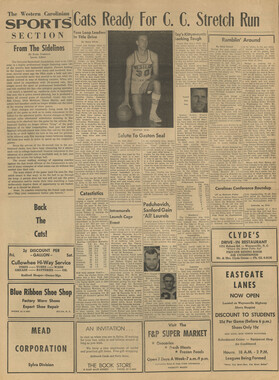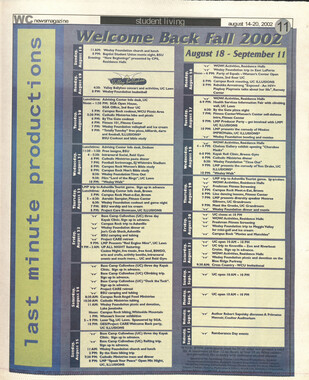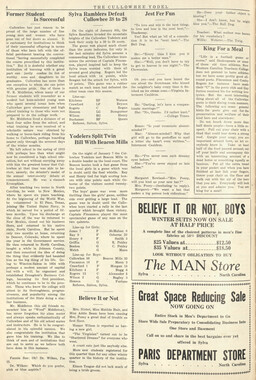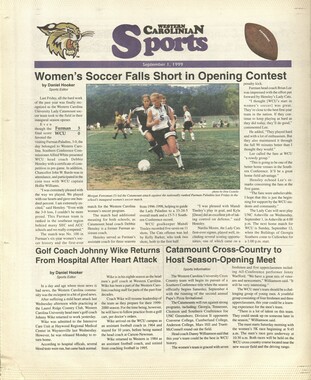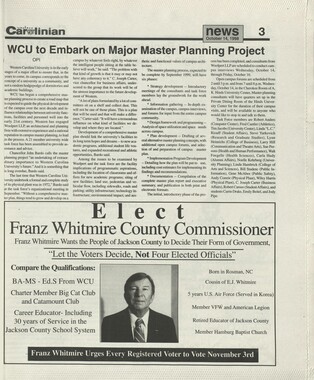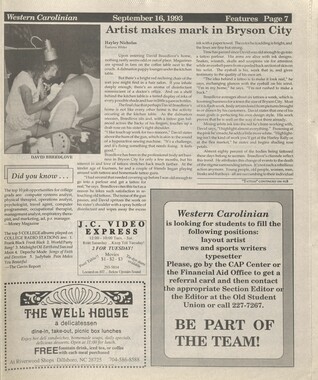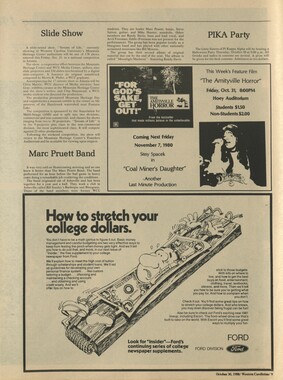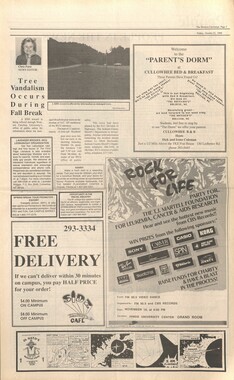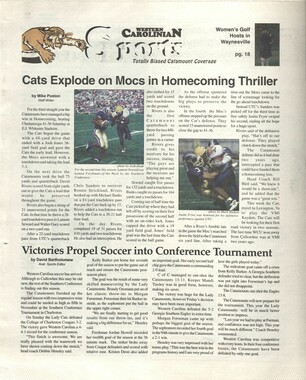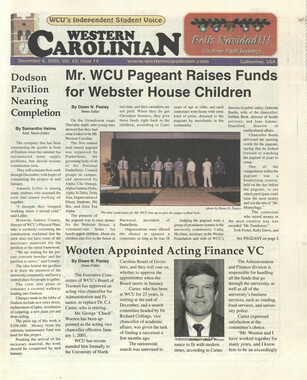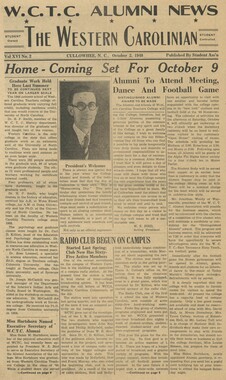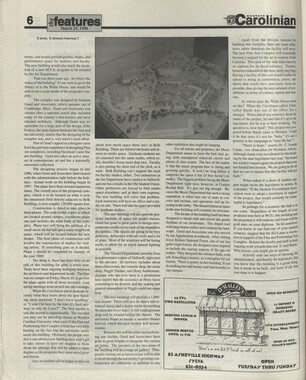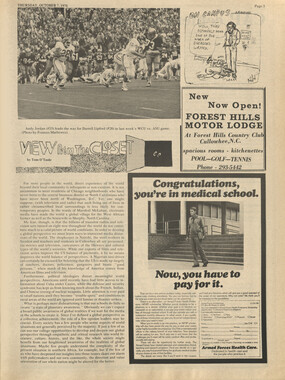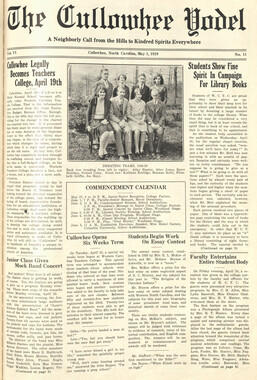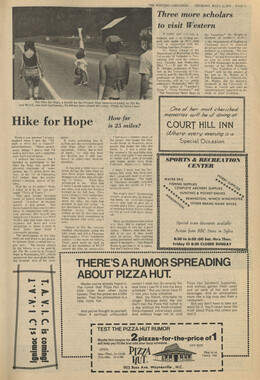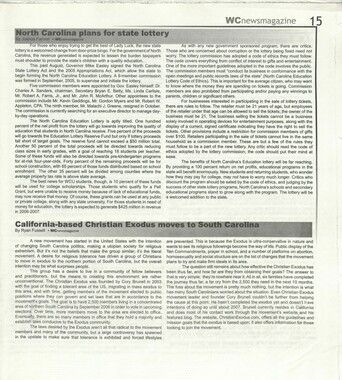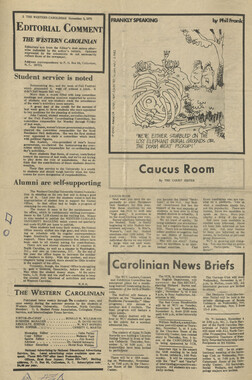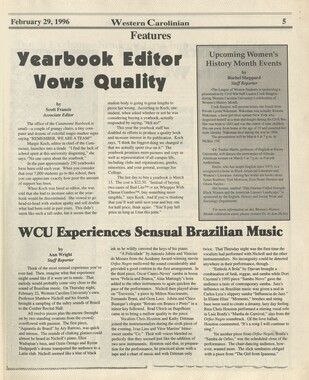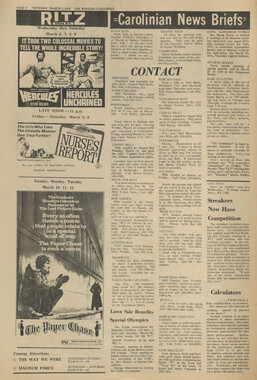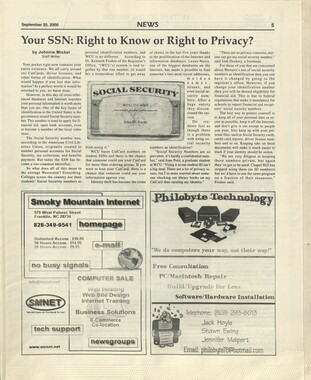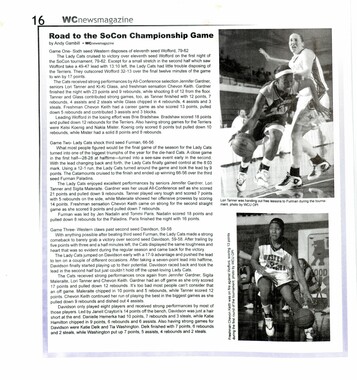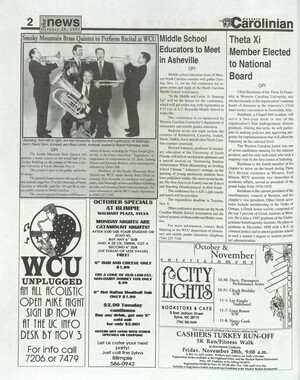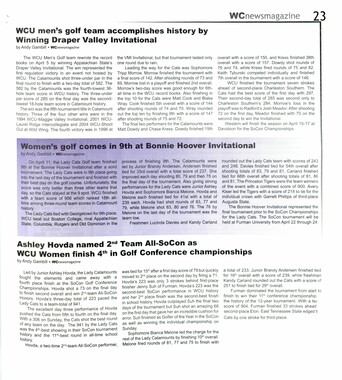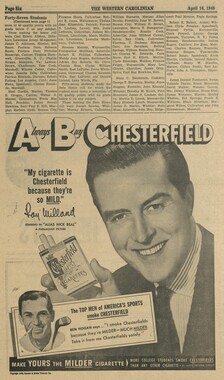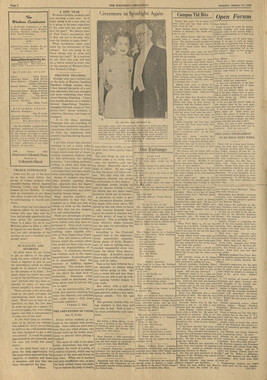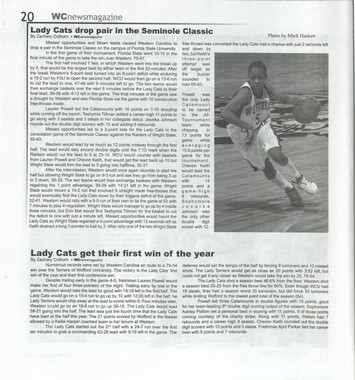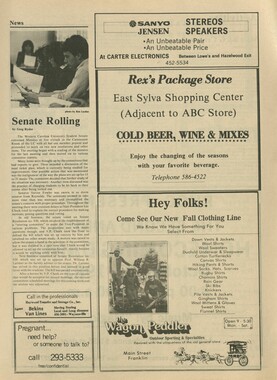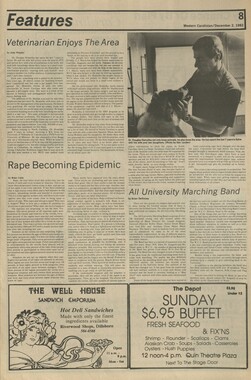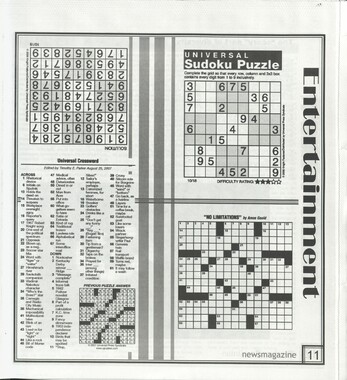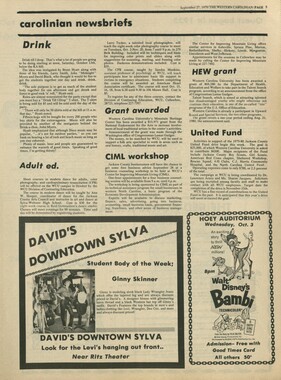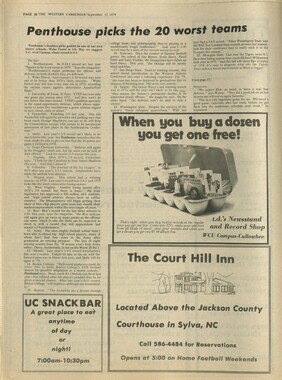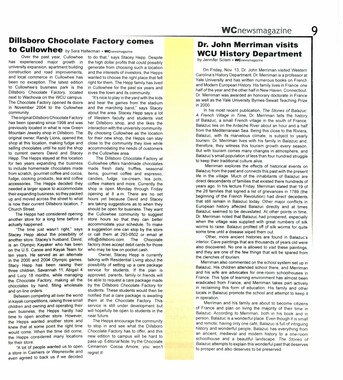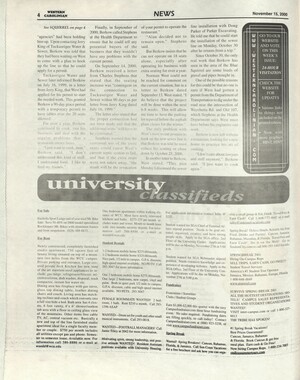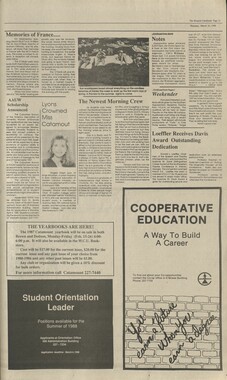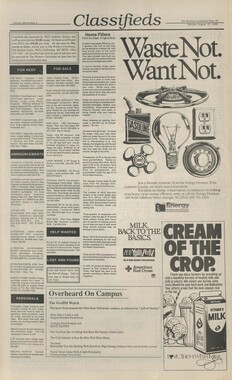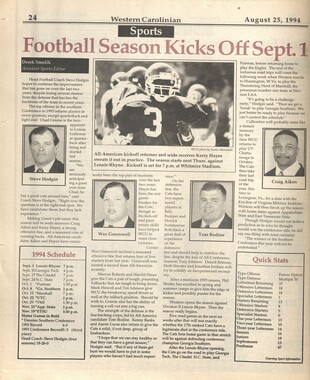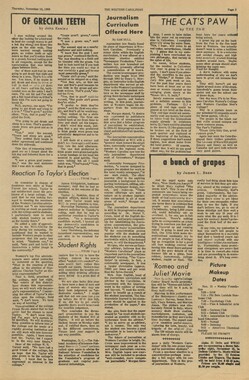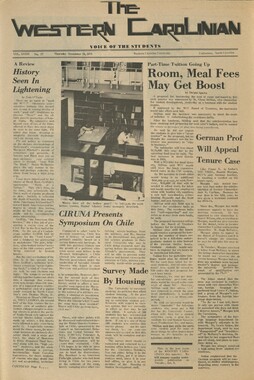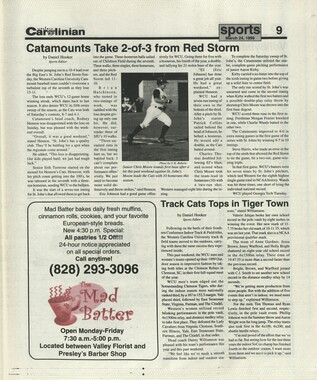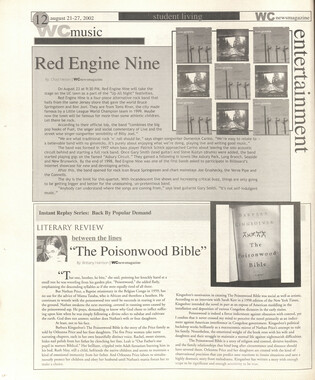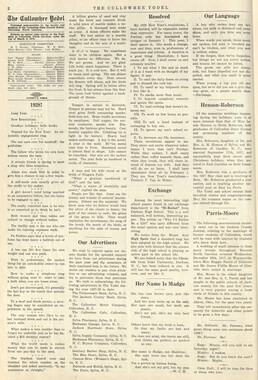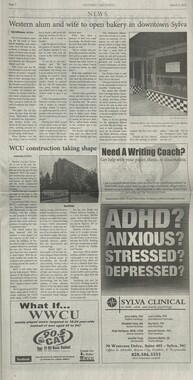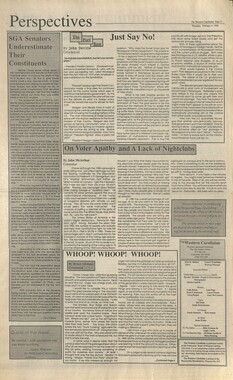Western Carolina University (21)
View all
- Canton Champion Fibre Company (2308)
- Cherokee Traditions (291)
- Civil War in Southern Appalachia (165)
- Craft Revival (1942)
- George Masa Collection (137)
- Great Smoky Mountains - A Park for America (2900)
- Highlights from Western Carolina University (422)
- Horace Kephart (941)
- Journeys Through Jackson (159)
- LGBTQIA+ Archive of Jackson County (85)
- Oral Histories of Western North Carolina (314)
- Picturing Appalachia (6797)
- Stories of Mountain Folk (413)
- Travel Western North Carolina (153)
- Western Carolina University Fine Art Museum Vitreograph Collection (129)
- Western Carolina University Herbarium (92)
- Western Carolina University: Making Memories (738)
- Western Carolina University Publications (2491)
- Western Carolina University Restricted Electronic Theses and Dissertations (146)
- Western North Carolina Regional Maps (71)
- World War II in Southern Appalachia (131)
University of North Carolina Asheville (6)
View all
- Allanstand Cottage Industries (62)
- Appalachian National Park Association (53)
- Bennett, Kelly, 1890-1974 (1463)
- Berry, Walter (76)
- Brasstown Carvers (40)
- Carver, George Washington, 1864?-1943 (26)
- Cathey, Joseph, 1803-1874 (1)
- Champion Fibre Company (233)
- Champion Paper and Fibre Company (297)
- Cherokee Indian Fair Association (16)
- Cherokee Language Program (22)
- Crowe, Amanda (40)
- Edmonston, Thomas Benton, 1842-1907 (7)
- Ensley, A. L. (Abraham Lincoln), 1865-1948 (275)
- Fromer, Irving Rhodes, 1913-1994 (70)
- George Butz (BFS 1907) (46)
- Goodrich, Frances Louisa (120)
- Grant, George Alexander, 1891-1964 (96)
- Heard, Marian Gladys (60)
- Kephart, Calvin, 1883-1969 (15)
- Kephart, Horace, 1862-1931 (313)
- Kephart, Laura, 1862-1954 (39)
- Laney, Gideon Thomas, 1889-1976 (439)
- Masa, George, 1881-1933 (61)
- McElhinney, William Julian, 1896-1953 (44)
- Niggli, Josephina, 1910-1983 (10)
- North Carolina Park Commission (105)
- Osborne, Kezia Stradley (9)
- Owens, Samuel Robert, 1918-1995 (11)
- Penland Weavers and Potters (36)
- Roberts, Vivienne (15)
- Roth, Albert, 1890-1974 (142)
- Schenck, Carl Alwin, 1868-1955 (1)
- Sherrill's Photography Studio (2565)
- Southern Highland Handicraft Guild (127)
- Southern Highlanders, Inc. (71)
- Stalcup, Jesse Bryson (46)
- Stearns, I. K. (213)
- Thompson, James Edward, 1880-1976 (226)
- United States. Indian Arts and Crafts Board (130)
- USFS (683)
- Vance, Zebulon Baird, 1830-1894 (1)
- Weaver, Zebulon, 1872-1948 (58)
- Western Carolina College (230)
- Western Carolina Teachers College (282)
- Western Carolina University (2008)
- Western Carolina University. Mountain Heritage Center (18)
- Whitman, Walt, 1819-1892 (10)
- Wilburn, Hiram Coleman, 1880-1967 (73)
- Williams, Isadora (3)
- Cain, Doreyl Ammons (0)
- Crittenden, Lorraine (0)
- Rhodes, Judy (0)
- Smith, Edward Clark (0)
- Appalachian Region, Southern (2929)
- Asheville (N.C.) (1944)
- Avery County (N.C.) (26)
- Blount County (Tenn.) (195)
- Buncombe County (N.C.) (1680)
- Cherokee County (N.C.) (283)
- Clay County (N.C.) (556)
- Graham County (N.C.) (238)
- Great Smoky Mountains National Park (N.C. and Tenn.) (525)
- Haywood County (N.C.) (3571)
- Henderson County (N.C.) (70)
- Jackson County (N.C.) (4917)
- Knox County (Tenn.) (35)
- Knoxville (Tenn.) (13)
- Lake Santeetlah (N.C.) (10)
- Macon County (N.C.) (420)
- Madison County (N.C.) (216)
- McDowell County (N.C.) (39)
- Mitchell County (N.C.) (135)
- Polk County (N.C.) (35)
- Qualla Boundary (982)
- Rutherford County (N.C.) (78)
- Swain County (N.C.) (2185)
- Transylvania County (N.C.) (270)
- Watauga County (N.C.) (12)
- Waynesville (N.C.) (86)
- Yancey County (N.C.) (72)
- Aerial Photographs (3)
- Aerial Views (60)
- Albums (books) (4)
- Articles (1)
- Artifacts (object Genre) (228)
- Bibliographies (1)
- Biography (general Genre) (2)
- Cards (information Artifacts) (38)
- Clippings (information Artifacts) (191)
- Copybooks (instructional Materials) (3)
- Crafts (art Genres) (622)
- Depictions (visual Works) (21)
- Design Drawings (1)
- Drawings (visual Works) (185)
- Envelopes (73)
- Exhibitions (events) (1)
- Facsimiles (reproductions) (1)
- Fiction (general Genre) (4)
- Financial Records (12)
- Fliers (printed Matter) (67)
- Glass Plate Negatives (381)
- Guidebooks (2)
- Internegatives (10)
- Interviews (815)
- Land Surveys (102)
- Letters (correspondence) (1013)
- Manuscripts (documents) (618)
- Maps (documents) (177)
- Memorandums (25)
- Minutes (administrative Records) (59)
- Negatives (photographs) (6090)
- Newsletters (1290)
- Newspapers (2)
- Notebooks (8)
- Occupation Currency (1)
- Paintings (visual Works) (1)
- Pen And Ink Drawings (1)
- Periodicals (193)
- Personal Narratives (10)
- Photographs (12976)
- Plans (maps) (1)
- Poetry (5)
- Portraits (4568)
- Postcards (329)
- Programs (documents) (181)
- Publications (documents) (2443)
- Questionnaires (65)
- Relief Prints (26)
- Sayings (literary Genre) (1)
- Scrapbooks (282)
- Sheet Music (2)
- Slides (photographs) (402)
- Songs (musical Compositions) (2)
- Sound Recordings (796)
- Specimens (92)
- Speeches (documents) (18)
- Tintypes (photographs) (8)
- Transcripts (322)
- Video Recordings (physical Artifacts) (23)
- Text Messages (0)
- A.L. Ensley Collection (275)
- Appalachian Industrial School Records (7)
- Appalachian National Park Association Records (336)
- Axley-Meroney Collection (2)
- Bayard Wootten Photograph Collection (20)
- Bethel Rural Community Organization Collection (7)
- Blumer Collection (5)
- C.W. Slagle Collection (20)
- Canton Area Historical Museum (2110)
- Carlos C. Campbell Collection (462)
- Cataloochee History Project (64)
- Cherokee Studies Collection (4)
- Daisy Dame Photograph Album (5)
- Daniel Boone VI Collection (1)
- Doris Ulmann Photograph Collection (112)
- Elizabeth H. Lasley Collection (1)
- Elizabeth Woolworth Szold Fleharty Collection (4)
- Frank Fry Collection (95)
- George Masa Collection (173)
- Gideon Laney Collection (452)
- Hazel Scarborough Collection (2)
- Hiram C. Wilburn Papers (28)
- Historic Photographs Collection (236)
- Horace Kephart Collection (861)
- Humbard Collection (33)
- Hunter and Weaver Families Collection (1)
- I. D. Blumenthal Collection (4)
- Isadora Williams Collection (4)
- Jesse Bryson Stalcup Collection (47)
- Jim Thompson Collection (224)
- John B. Battle Collection (7)
- John C. Campbell Folk School Records (80)
- John Parris Collection (6)
- Judaculla Rock project (2)
- Kelly Bennett Collection (1482)
- Love Family Papers (11)
- Major Wiley Parris Civil War Letters (3)
- Map Collection (12)
- McFee-Misemer Civil War Letters (34)
- Mountain Heritage Center Collection (4)
- Norburn - Robertson - Thomson Families Collection (44)
- Pauline Hood Collection (7)
- Pre-Guild Collection (2)
- Qualla Arts and Crafts Mutual Collection (12)
- R.A. Romanes Collection (681)
- Rosser H. Taylor Collection (1)
- Samuel Robert Owens Collection (94)
- Sara Madison Collection (144)
- Sherrill Studio Photo Collection (2558)
- Smoky Mountains Hiking Club Collection (616)
- Stories of Mountain Folk - Radio Programs (374)
- The Reporter, Western Carolina University (510)
- Venoy and Elizabeth Reed Collection (16)
- WCU Gender and Sexuality Oral History Project (32)
- WCU Mountain Heritage Center Oral Histories (25)
- WCU Oral History Collection - Mountain People, Mountain Lives (71)
- WCU Students Newspapers Collection (1923)
- Western North Carolina Tomorrow Black Oral History Project (69)
- William Williams Stringfield Collection (2)
- Zebulon Weaver Collection (109)
- African Americans (390)
- Appalachian Trail (35)
- Artisans (521)
- Cherokee art (84)
- Cherokee artists -- North Carolina (10)
- Cherokee language (21)
- Cherokee pottery (101)
- Cherokee women (208)
- Church buildings (190)
- Civilian Conservation Corps (U.S.) (111)
- College student newspapers and periodicals (2012)
- Dams (108)
- Dance (1023)
- Education (222)
- Floods (61)
- Folk music (1015)
- Forced removal, 1813-1903 (2)
- Forest conservation (220)
- Forests and forestry (1196)
- Gender nonconformity (4)
- Great Smoky Mountains National Park (N.C. and Tenn.) (181)
- Hunting (46)
- Landscape photography (25)
- Logging (119)
- Maps (83)
- Mines and mineral resources (9)
- North Carolina -- Maps (18)
- Paper industry (38)
- Postcards (255)
- Pottery (135)
- Railroad trains (72)
- Rural electrification -- North Carolina, Western (3)
- School integration -- Southern States (2)
- Segregation -- North Carolina, Western (5)
- Slavery (5)
- Sports (452)
- Storytelling (243)
- Waterfalls -- Great Smoky Mountains (N.C. and Tenn.) (66)
- Weaving -- Appalachian Region, Southern (280)
- Wood-carving -- Appalachian Region, Southern (328)
- World War, 1939-1945 (173)
Western Carolinian Volume 20 (89) Number 10 (02)
Item
Item’s are ‘child’ level descriptions to ‘parent’ objects, (e.g. one page of a whole book).
-
-
ARTS AND ENTERTAINMENT ae Western Carolinian April 2, 201985 Choir features women writers Garland Wells tling statisticout soloists wereKhue mood of the music. Staff Writer of the 1,200 choral Levy, Jean Oliver, Joy in the Morn- On March 5, the works housed in Destinee Penzo, ing 4977) was choir. Wisdom of the Moon (2017) was ensembles presence. The second tune, When Gabriel Wreatorts Carolina the WCU Choral Patrick Richterand one of the songs Blows His Horn a more recent piece Se erie haika nd Library, only 8 Gabe Spivey on per- ondisplay overthe (1939) wasunmis- that came from University Chorus were composed by __ cussion. evening thatcame __ takably inspired composer Susan women. She goes Next, they per- from the aforemen-__ by the music of LaBarr and lyricist .came together to present a concert centered around compositions ex- clusively written by women. Both ensembles were ~ conducted by Dr. Allison Thorp with accompaniment by Ann Tiner. It was held in the Bardo Arts Center Con- cert Hall, which was largely packed in attendance. The University Chorus performed a four song set, followed by a five song set by the Concert Choir. In every program for the show, there was a purple typed note with a list of all the upcoming events in the Wom- ens History Month Series, a collabora- tive project of the WCU Music and English Depart- ment. In addition to the schedule and list of performers, there was a note from Dr. Allison Thorp discussing the need for expo- sure in regards to women composers. She states a star- Stage dunior Editor From Feb. 28 to March 3, the Western Carolina University School of Stage and Screen presented the play The Wolves in the Josephina Niggli Studio Theatre in the Bardo Arts Center. The play was directed by Acting Program Director and Assis- tant Professor Dustin Whitehead who chose the show because he had attended a perfor- mance of it in Chicago and found it to be a powerful play. The show followed a girls indoor soccer team as they navigated through their own personal and aca- demic issues as well as struggles within the team. The cast was entirely female, with sophomore Rachel one Sabo-Hedges as the Team Captain #25, : junior Anna Broad- ' way as Player #7, + sophomore Amanda ' Dowswell as Player - #14, freshman Ariana Haylock as Player #11, senior Sara Lucas as Player #13, sopho- ~ more Micah Patt as New Girl and Player - #46, sophomore Kate McCosh as Player #2, . freshman Jenna Gilm- er as Player #8 and sophomore Breanna Smith as Team Goalie re = #00. Dance and Musi- _ cal Theatre Program KA tee - Director and Assistant . Professor Ashlee Was- " -mund also appeared at is the end of the show as - #14s mother. Each scene of the G = play showed the girls ~ warming up before the latest game under the = direction of their cap- tain. The first scene = opens with several of ..-Sthe girls discussing the < death sentence of a Cambodian murderer, with other girls either interjecting or starting up their own overlap- on to finish the note with a thought on the status of gender sisawe, as our choral library dem- onstrates, we still have a long way to go. The University Chorus took the stage, and they were an impressive group in size and talent. They opened the concert with a piece entitled E. Oru O, which was based on a Nigerian Folk Song. The 2001 arrangement was provi by Rosep- anye Powell, with the text originating from the Yoruba language. Powell is a powerful force in the movement to incorporate more compositions by women and Afri- can-American com- posers into the main choral libraries. The piece was writ- ten to allow room for improvisational movement and percussion, as well as choral soloing. It served to kick the proceedings off on an upbeat note. The and Screen ping conversations. This created a casual atmosphere for the . play and added to the hilarity of the various conversations. Throughout each scene or week and into the next, the girls personalities as well as their changing rela- tionships with each other were revealed and more secrets came to light. They learned more about the new girl, share their anxiet- ies about scouts show- ing up to the games and gossiped about their personal drama, which included social anxiety disorder and even an abortion. One of the stories within the play was about the new girl (#46). As she began to fit in more, she revealed more of her story to the rest of the team. One of her team- mates suspected she lived in a yogurt but she later shyly correct- ed her to say she really lived in a yurt. She also reveals that she is a good player because her mom is a travel writer who took her on her trips around the world. This allowed her to play soccer with children all over the world, which also al- lowed her to become a star player. This lead her to step up after the teams striker, player #7, sustained an injury during the third game of the season. As #46 outshone #7 on the field, #7 continued to deal with drama with player #14 from their ski trip the previ- ous weekend. As #14 expressed her anger about the trip, it was revealed that #7 had left #14 alone with her boyfriends college friend as she went off with her boyfriend. The interaction ended on a sour note as the girls went out formed Jenny Re- becca (1964), with music and text by Carol Hall, arrange- ment Clair T. McEI- fresh. The piece was a sweet song revolving around the themes of birth and new life. Inter- estingly noted in the program was the fact that the song was performed by a rising star named Barbara Streisand when it was first written. TI Have Loved the Stars (2016) was their penultimate piece and it featured Mary Freeman on bassoon. The liner notes asserted that the piece was written to use im- agery of nature in an effort to speak on the transience of mortality. The piece had a haunt- ing quality to it that evoked an atmo- sphere of reflection and introspection. Additiennny, the piece was conducted by Michelle Lang, who did a com- mendable job in di- recting the complex onto the field. sion ran high toward the end of the play with the loom of personal and team drama over the girls heads. The scene before the finale showed only the goalie as she battled with an anxiety attack after a lost game and also highlighted that some- thing else might have occurred outside of the field. During the last scene, the girls ar- rived one by one to the sideline with a cloud of sadness over them. As they spoke to each other, it became clear there was another rea- son they were down- trodden--there was a death within the team. #14 had been killed after being hit by a car during a run outside in the snow. As the girls began to warm up for the upcoming game, #14s mother approaches the girls and tries to give them a pep talk as she works through her own emo- tional anguish. The show ended with the girls doing their chant in a huddle to encour- age themselves. Assistant Stage Manager Jasmine Herbert said to put on the show, It took teamwork and co- operation with each other because its such and ensemble-heavy play, and that doesnt just include the actors, that included stage management and the directors as well. The next show will be the mainstage musical Disneys Beauty and the Beast on April 11-14, with senior Musical Theatre major Annie Sorey as Belle and senior Anthony Sims as the Beast. To learn more about upcoming shows contact the School of Stage and Screen at (828) 227-7491 or at sas@wcu.edu. tioned WCU Choral Library. The piece had been written by composer Natalie Sleeth for the occa- sion of her husband being inaugurated as the new president of West Virginia Wesleyan College. The piece certainly had a sacred work flavor to it that also conveyed a sense of uplifting celebra- tion. It was a good note to end for the main ensemble and left an air of excite- ment for the second half of the show. The Concert Choir was an equally impressive size and contained an equal amount of talent across the board. The first two pieces they performed had a religious bent. The first, Hark, I Hear the Harps Eternal (1967) was based on an arrangement by prolific composer and arranger Alice Parker. The piece featured soloists Jes- sica McIntyre and Garrett Glove. The piece was booming and ushered in the African-American spirituals. The music and text both sourced from Mar- garet Springfield and originated from issued revolving around segregation in the south. The piece was slower and darker than its predecessor but con- tained a hypnotic power and sense of profundity. The soloists were Mi- chelle Lang, Chris- tine Reeder, Jacob Plaisted and David Benoit. The melancholy Wanting Memo- ries (1980) from multi-disciplined artist Ysae Maria Barnwell marked the centerpiece of the performance. As described in the program, Barnwell composed the piece as a part of a cycle entitled Crossings, in an attempt to express her feelings over the death of her grandmother. There were no solo- ists in the piece, and it served as a real display of unified talent across the The program for The Wolves. Jan Richardson. As a point of connec- tion, LaBarr studied under previously featured composer Alice Parker. The lyrics for the piece stem from the un- expected death of Jan Richardsons husband and writ- ing partner. The piece was filled with emotion and sorrow and was one of the more powerful mo- ments of the night. The piece featured Lauren Chandgie and Colin Whitely as soloists. Finally, the night ended with Carly Si- mons Let the Riv- er Run (1988). The song was written for the film Working Girl and received a Grammy, Oscar and Golden Globe, the first song by a single artist to ever do so. Its a great song, and with percussion accompaniment by Connor Knox and Jessica McIntyre and Ally Vickery on piano, it was a great and jubilant way to conclude the perfor- mance. presents The Wolves Photo submitted by Elora DuClos
Object
Object’s are ‘parent’ level descriptions to ‘children’ items, (e.g. a book with pages).
-
The Western Carolinian is Western Carolina University's student-run newspaper. The paper was published as the Cullowhee Yodel from 1924 to 1931 before changing its name to The Western Carolinian in 1933.
-
